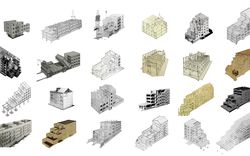The Coloniality of an Executive Order
Samia Henni defends architectural “possibilities of an otherwise”
On 4 February 2020, the U.S. magazine Architectural Record published an article, Will the White House Order New Federal Architecture to be Classical? in which it announced that the Trump administration had proposed an executive order titled “Make Federal Buildings Beautiful Again.” Supported by the National Civic Art Society,1 the seven-page draft of the order states that: “in the 1950s the Federal government largely abandoned traditional, classical designs, and began adopting mid-century modernism, including Brutalism, for Federal buildings;”2 and advocates that “architectural styles—with special regard for the classical architectural style—that value beauty, respect regional architectural heritage, and command admiration by the public are the preferred styles for applicable Federal public buildings.”3 The text argues that neoclassical architecture (instead of the misnomer “classical architecture” mentioned in the order) epitomizes the “self-governing ideals” of George Washington and Thomas Jefferson and cherishes the architectures of ancient Athens and Rome for their “beauty and visual embodiment of America’s ideals.”4 Since the proposal, the American Institute of Architects, the American Society of Landscape Architects, the Society of Architectural Historians, the National Trust for Historic Preservation, Docomomo U.S., The Architectural Lobby, and many other organizations, journals, newspapers, and individuals have declared their concern and opposition to the order. Besides recalling the obvious symbols of this architectural language, this essay endeavours to unpack the violent coloniality that the text of the executive order embodies.
As some oppositions to the executive order affirmed, the prescription of neoclassical architectural style as “the preferred and default style” for new U.S. federal public buildings at home and abroad—as well as for their renovation, reduction, or expansion—signifies a continuation of U.S. imperialism. The Capitol Building and the White House, both constructed during the late eighteenth century and mentioned in the executive order, may be espoused in the executive order as “symbols of democratic self-government,”5 but are as pervasively icons of the Ancient Greek and Roman Empires, of the colonization of the Americas, of the annihilation of Indigenous people and their environment, and of the enslavement of African people. Imported by Europeans from Western Europe, this very architectural style testifies to a colonial presence in a colonized territory. In addition to fortifying conservatism and Eurocentrism incarnate in U.S.-centrism, and undermining design freedom and contemporaneity, the order eulogizes the massacres of Native Americans, enslaved African people, and other oppressed communities to ultimately reinforce white supremacy. Moreover, the idea of erecting a neoclassical building today evokes images from the Second World War, when Benito Mussolini in Italy and its colonial empire, Adolf Hitler in his Third Reich, Joseph Stalin in his empire, and others ordered the use of classical aesthetics to mark their occupied territory, unify the physical appearance of their presence, and celebrate powers that were certainly not based on democratic values.
This centralized order opposes not only the U.S. Guiding Principles for Federal Architecture issued in 1962, which prevented the imposition of a uniform federal architectural style, but also contests the efforts of numerous architecture instructors as well as the National Architectural Accrediting Board (NAAB)—the organization that accredits architectural education programs—to “ensure that students understand the histories and theories of architecture and urbanism, framed by diverse social, cultural, economic, and political forces nationally and globally.”6 This endeavour invites educators to revisit syllabi, study, and discuss architects, buildings, movements, theories, and historical events from a transcultural, transnational, and trans-geographic perspective. The order is, in fact, in opposition to this standpoint. It opposes criticality, inclusiveness, and diversity. It incites to preserve a conservative attitude often entangled with masculine white Eurocentric principles. This is not a critique of scholars who identify as such and have, as many others, contributed to architectural histories and theories, but rather is an observation that, even as a not-homogenous group, they do not, and cannot, represent everyone.
To denote and acknowledge the histories of destroyed and built environments in the U.S.—both violent processes—is to expose the coloniality of history-writing and policy-making and simultaneously urge for an intersectional analysis of architecture and the political. Introduced by sociologist Aníbal Quijano in the 1990s, the concept-term coloniality can be defined as a process of domination and dispossession, which began with the devastation of the Americas in 1492 and continues to this day. This dispossession was architectural, territorial, environmental, cultural, linguistic, and educational—and such strategies are particularly reinforced today with the rise of right-wing nationalists around the world. According to Quijano, one of the fundamental principles of coloniality of power “is the social classification of the world’s population around the idea of race, a mental construction that expresses the basic experience of colonial domination and pervades the more important dimensions of global power, including its specific rationality: Eurocentrism.”7 In this context, Eurocentrism—embodied in U.S.-centrism—fortifies the self-justification and self-legitimization of the supremacist attitude of among settler-colonial Europeans, which is rooted in systems and notions that they themselves created, controlled, and disseminated. To this end, a systematic racial division and classification of space and architecture—of form, style, colour, building materials, etc.—was, and is still, imposed. This approach is undeniably associated with the exploitation and extermination of then-existing environments, places, spaces, and people.
The coloniality of the executive order’s Eurocentric nature confirms the plurality of the discrimination that the order unscrupulously cultivates. Along with race, there are other stratifications, such as class, religion, and gender, that the order appositely overlooks. In fact, it has no intention to be intersectional. The term intersectionality was coined by lawyer and scholar Kimberlé W. Crenshaw in a paper titled Demarginalizing the Intersection of Race and Sex: A Black Feminist Critique of Antidiscrimination Doctrine, Feminist Theory and Antiracist Politics, which she published in 1989. Crenshaw analyzes the explicit interrelations of racism and sexism from a structural, political, and representational perspective as seen through the systematic legal exclusion of black women, a specific cluster of people often neglected in feminist theories centring white women and anti-racist policies centring black men. From an intersectional viewpoint, “Make Federal Buildings Beautiful Again” does not make any effort to represent the multiple profiles and diverse backgrounds of U.S. taxpayers who might prioritize other urgent obligations when it comes to architecture. They might want to see their taxes used to promote equal, diverse, and inclusive norms and forms, to help address anthropogenic climate change or support efforts in renewable energy and sustainable building materials.
A critique of the coloniality of this order entails the possibility for decoloniality, which is not to be mistaken with decolonization. Decoloniality can be understood, as Walter D. Mignolo and Catherine Walsh argue in their book On Decoloniality: Concepts, Analytics, Praxis, “as an analytic…necessarily tied to the lived contexts of struggle, struggles against the structures, matrices, and manifestations of modernity/coloniality/capitalism/heteropatriarchy, among other structural, systemic, and systematic modes of power, and for the possibilities of an otherwise.”8 Unlike decolonization, which is largely associated with the political independence of colonized territories, decoloniality promotes a relationality, or condition of relating, that “[builds] understandings that both cross geopolitical locations and colonial differences, and [contests] the totalizing claims and political-epistemic violence of modernity.”9 This relationality intends to be pluriversal, containing multiple epistemologies, and “unsettles the singular authoritativeness and universal character,”10 while the executive order clearly proposes and defends such a singular perspective. The conservative demand for adopting a universal architectural language is unsurprisingly rooted in the coloniality of power, and its totalizing claims should be contested and opposed. “The possibilities of an otherwise” are fundamental rights.
The order corroborates that not only “[is there] no modernity without coloniality,”11 but there is also no decoloniality without colonialization. Colonization exists in different forms; that is to say, decoloniality is omnipresent. Colonization exists through the physical invasion and occupation of lands. It exists through military operations and civil measures. It exists through the material and psychological subjugation and exploitation of human and natural resources. It exists through man-made environmental transformations and ecological interventions. It exists through global mechanisms of accumulation by dispossession. It exists through technological threats, digital strategies of businesses, and surveillance. It exists through profound socio-economic and gender inequities. It exists through the implicit or explicit maintenance of power, domination, and war. It exists through forced erasures of tradition, religion, and culture. It exists through the uncritical imposition of specific language, literature, and knowledge. It exists through the labour forces of construction, material extraction, and industry. It exists at the very heart of destructed, projected, and built environments. These processes are often violent and traumatic.12
Whereas intersectional thinking undoes various coexisting social stratifications, a decolonial practice disrupts the colonial, or modern Eurocentric, ramifications of power, policy-making, and history-writing. In concrete terms, for instance, to historicize architectural histories and theories of the early modern period, one cannot but include the production, consumption, and dissemination of colonial discourses, architecture, and planning throughout the abundant overseas colonized territories, departments, and protectorates of the European empires. During this long period, numerous British, Dutch, French, German, Italian, Portuguese, and Spanish architects, engineers, planners, civil servants, and military officers were involved in building the wealth and infrastructure of European empires—including that which later became known as the U.S.A.—and developing architectural knowledge, technologies, and techniques. The executive order purposefully ignores that architectural formation is often associated with doctrines and politics of dispossession, wars, violence, and capital accumulation. This colonial attitude offends, and it does what it meant to do: it fortifies the dominance of a group of people over many others.
Paradoxically, the order rejects “mid-century modernism, including Brutalism,”13 which is also a European production, claiming that “America’s ideals” can only be visually embodied in the “classical architecture” of ancient Athens and Rome. This formal and linguistic constellation, which can be deemed as a colonial attitude by some, and a supremacist impulse by others, reiterates that the order symbolizes a nostalgia for an architectural language in the United States of America that is not only European, but profoundly imperial. Once again, the coloniality of this executive order illuminates the violent face of European colonialism, and its rhetoric of self-legitimization through its “civilizing mission” and projects of modernity including architectural, infrastructural, and planning endeavours.
However, the diversity and complexity of architectural histories and theories must be defended against forms of colonization beyond and within the discipline. To avoid manipulations, misusages, and erasures, there is a need for architectural pedagogies that are inspired and informed by decolonial and intersectional thinking and making. Architecture schools should do more to combat this violence and begin or continue to teach, encourage, facilitate, accommodate, and voice current and future architectural “possibilities of an otherwise.”
-
Founded in 2002, the National Civic Art Society is a private organization based in Washington, D.C. that promotes neoclassical art and architecture. ↩
-
Making Federal Buildings Beautiful Again, 1, accessed 30 April 2020. ↩
-
Ibid, 3. ↩
-
Ibid. ↩
-
Ibid, 1. ↩
-
National Architectural Accrediting Board, Inc., Conditions of Accreditation, 2020 Edition, accessed on 5 May 2020. ↩
-
Anibal Quijano, “Coloniality of Power, Eurocentrism, and Latin America,” Nepantla: Views from South, vol. 1, no. 3 (September 2000): 533–580. ↩
-
Walter Mignolo and Catherine E. Walsh, On Decoloniality: Concepts, Analytics, Praxis (Durham: Duke University Press, 2018), 49–50. ↩
-
Ibid, 1. ↩
-
Ibid, 1–2. ↩
-
Ibid, 4. ↩
-
Samia Henni, Colonial Ramifications, E-Flux Architecture, History/Theory, gta Institute, ETH Zurich (31 October 2018). ↩
-
Making Federal Buildings Beautiful Again, 2, accessed 20 May 2020. ↩















